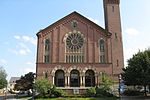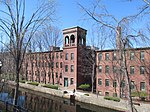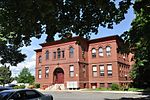Chicopee River

The Chicopee River is an 18.0-mile-long (29.0 km) tributary of the Connecticut River in the Pioneer Valley, Massachusetts, known for fast-moving water and its extraordinarily large basin: the Connecticut River's largest tributary basin. The Chicopee River originates in a Palmer, Massachusetts village called Three Rivers as a confluence of the Ware, Quaboag and Swift rivers. It passes through Wilbraham, Ludlow, and the Indian Orchard neighborhood of Springfield. After forming the border between Springfield and Chicopee, Massachusetts for a short distance, the river then flows in a sharply curving path through the city of Chicopee and into the Connecticut River. (Chicopee was part of Springfield until 1848.)
Excerpt from the Wikipedia article Chicopee River (License: CC BY-SA 3.0, Authors, Images).Chicopee River
Depot Street, Chicopee
Geographical coordinates (GPS) Address Nearby Places Show on map
Geographical coordinates (GPS)
| Latitude | Longitude |
|---|---|
| N 42.1482 ° | E -72.6217 ° |
Address
Depot Street
Depot Street
01013 Chicopee
Massachusetts, United States
Open on Google Maps









